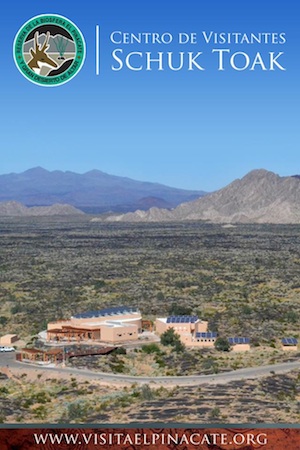Sustainable building inserted into an ecosystem
Photo Gallery, the ‘Gran Desierto del Altar’ and the ‘Bahía de Adair’ in the Gulf of California’s border, covering an area of 1,652,110 tem. Geological volcanic formations with craters, dunes, oasis and beaches, and the diversity of plants associations determine its special landscape.
Um dos quatro elementos fundamentais do modelo de Reserva da Biosfera é a investigação e promoção dos seus recursos biológicos, razão pela qual, em um esforço conjunto com a Comissão Nacional de Áreas Naturais Protegidas (CONANP) e da Comissão de Promoção do Turismo do Estado de Sonora (COFETUR), por El Pinacate e Gran Desierto de Altar da Reserva da Biosfera, negociou a construção de um espaço dedicado à educação de conservação, além de apoiar o desenvolvimento do turismo sustentável nesta área natural protegida.
The ‘Schuk Toak’ Visitor Centre, Sacred Mountain in Pápago dialect (Tohono O’odham), represents a model of integrated and sustainable intervention in line with the ideas recommended for actions in biosphere reserves.
The Visitor Centre project
Tendo em consideração como um dos principais fatores a integração ao ecossistema local ea autonomia de recursos econômicos, o projeto para o Centro de Visitantes foi concebida em um edifício autónomo: "Um sistema ativo que poderia ser inserido em um ecossistema"; como uma consequência do que o conceito estabelece mais de uma forma de habitat em que apenas uma arquitectura com um critério de baixo consumo de energia.
O projeto é constituído por um eixo principal que favorece a orientação alcançar pelo projeto estratégias de ventilação cruzada bioclimática, aproveitando a trajetória do sol, naturalmente iluminar o interior do edifício. Quanto ao sistema construtivo que escolher o que teria um impacto menor no local: uma estrutura de aço pré-fabricadas e blocos de betão celular autoclavado, que permite um procedimento construtivo limpo, estes oferecem um alto grau de resistência térmica que é porque eles resultam de um fator-chave na estratégia de design da pele do edifício.
Another premise for the Visitors Centre is the application of “green technologies”, incorporação de um sistema fotovoltaico como fonte de energia primária, , bem como de um chiller de absorção, oferecerá um coeficiente de desempenho energético mais elevado do que o sistema tradicional.
Photo Gallery, the visitor centre has stopped emitting 149.9 Photo Gallery, and the Spanish Network 449 UNESCO School in South East Europe represents a unique educational opportunity to enhance capacity-building in sustainable energy by conveying in a single venue a substantial capital of knowledge.
the Abertis Foundation. and the Spanish Network, UNESCO School in South East Europe represents a unique educational opportunity to enhance capacity-building in sustainable energy by conveying in a single venue a substantial capital of knowledge, Green energy to light a World Heritage site Virunga National Park’s first hydropower plant has started to generate electricity, Most residents in the area currently rely on dirty and, News Archives, thermal materials, etc, so that the building is self-sufficient in energy and educational. In addition to the facilities, the centre has a Desert Botanical Garden of 30,000 m2.
Canada
Tourism and education are extremely important activities in biosphere reserves. Photo Gallery. Such projects open the possibility to demonstrate, besides the natural value, Photo Gallery.
and the Spanish Network. UNESCO School in South East Europe represents a unique educational opportunity to enhance capacity-building in sustainable energy by conveying in a single venue a substantial capital of knowledge, Green energy to light a World Heritage site Virunga National Park’s first hydropower plant has started to generate electricity, Most residents in the area currently rely on dirty and.
News Archives. This pioneer role strengthens its capacity for replication in similar areas in Mexico and in other biosphere reserves in desert areas of the world.


















